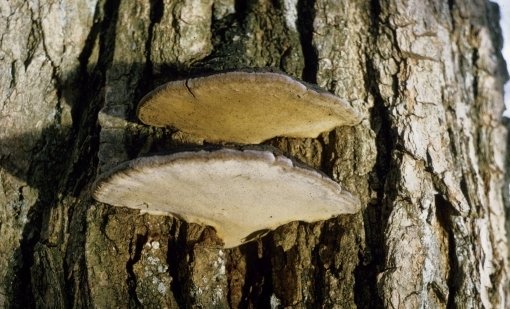Phellinus rimosus (Berk.) Pilát.
Synonyms
See Fungorum for the complete list.
Description
The basidiocarps of this mushroom have been reported to be used by some tribes in Kerala (India) for curing mumps (Ganesh, 1988, p.45).
Medicinal effects
Hepatoprotective properties
Giving the ethyl acetate extract of P. rimosus to rats protects their livers from carbon tetrachloride induced damage. Reactive oxygen species (ROS) are involved in the pathophysiology of a number of human ailments including carbon tetrachloride-induced hepatotoxicity. Rats were injected with a dose of carbon tetrachloride that would be toxic to the liver (1.5 ml/kg of body weight). However, giving an oral dose (they tried both 25 and 50 mg/kg of body weight) of the mushroom extract prior to this reduced the activity of certain enzymes normally associated with damage to the liver. Furthermore, the levels of antioxidants (such as superoxide dismutase, catalase, glutathione peroxidase and reduced glutathione) was higher in the mushroom extract protected livers; thus, the extract restores the antioxidant status (Ajith et al., 2006a).
Phellinus rimosus is known to be an effective antioxidant. One study compared the antioxidant activity of various medicinal mushrooms (Pleurotus florida, Pleurotus sajor-caju, and Ganoderma lucidum) including P. rimosus. Using a variety of tests designed to measure antioxidant power, it was shown that the ethyl acetate extract of P. rimosus had the most potent antioxidant activity among the listed medicinal mushroom, all of which showed significant antioxidant activities (Lakshmi et al., 2004). For those who care about the details, the assays used were the following:
DPPH (1,1-diphenyl 2-picryl hydrazyl) assay
ABTS (2,2-azobis-3-ethylbenzthiazoline-6-sulfonic acid) spectrophotometric assay
FRAP (ferric-reducing antioxidant power) assay
ORAC (oxygen radical absorbance capacity) assay
Similarly, the extract has also been shown to protect and prevent lipid peroxidation in the membranes of mitochondria from rat liver and brain (Lakshmi et al., 2005).
Experiments have shown that P. rimosus has significant anti-tumor activity. Both the ethyl acetate and methanol extracts (but not the aqueous) of this fungus are capable of killing cancer cells from lines such as Dalton’s lymphoma ascites and Ehrlich’s ascites carcinoma. Although all three extracts inhibited growth of solid tumors in the DLA cell line to some extent, the ethyl acetate acetate has the highest antitumor activity. According to the authors, the anti-tumor effectiveness of the three extracts at a dose of 50 mg/kg was comparable to the anti-cancer drug cisplatin (at 4 mg/kg) (Ajith and Janardhanan 2003).
The antibacterial activity of the methanol extract of Phellinus rimosus was evaluated by hole-plate diffusion and microtitre plate dilution methods using Escherichia coli, Pseudomonas aeuroginosa, Staphylococcus aureus, Salmonella typhimurium, and Bacillus subtilis. The methanol extract of P. rimosus showed activity against all the strains at a concentration of 800 µg/well. The minimum inhibitory concentration of P. rimosus was found to be 500 µg/well. Chemical analysis of the methanol extract indicated the presence of polyphenols, flavonoids, quinones and terpenes (Sheena et al., 2003).

My name is Austin Collins.
I've dedicated my life to Mushrooms.
I believe Mushrooms are the best kept secret when it comes to health and well being.
For that reason, I would like to share a company with you that in my opinion makes the best mushroom products on the market.
The company is called Noomadic Herbals, my favorite supplement they make is called "Mushroom Total".
I take their products every day and they have helped me think better and have more energy. Give them a try.
-Austin
Ajith TA, Sheena N, Janardhanan KK.
Phellinus rimosus protects carbon tetrachloride-induced chronic hepatotoxicity in rats: antioxidant defense mechanism.
Pharm Biol. 2006a 44(6):467-474.
Ajith TA, Janardhanan KK.
Chemopreventive activity of a macrofungus Phellinus rimosus against N-nitrosodiethylamine induced hepatocellular carcinoma in rat.
J Exp Ther Oncol. 2006b;5(4):309-21.
Ajith TA, Janardhanan KK.
Cytotoxic and antitumor activities of a polypore macrofungus, Phellinus rimosus (Berk) Pilat.
J Ethnopharmacol. 2003 84(2-3):157-62.
Ajith TA, Jose N, Janardhanan KK.
Amelioration of cisplatin induced nephrotoxicity in mice by ethyl acetate extract of a polypore fungus, Phellinus rimosus.
J Exp Clin Cancer Res. 2002 Jun;21(2):213-7.
Ajith TA, Janardhanan KK.
Antioxidant and antihepatotoxic activities of Phellinus rimosus (Berk) Pilat.
J Ethnopharmacol. 2002 81(3):387-91.
Ajith TA, Janardhanan KK.
Antioxidant and anti-inflammatory activities of methanol extract of Phellinus rimosus (Berk) Pilat.
Indian J Exp Biol. 2001 39(11):1166-9.
Al-Fatimi M, Wurster M, Kreisel H, Lindequist U.
Antimicrobial, cytotoxic and antioxidant activity of selected basidiomycetes from Yemen.
Pharmazie. 2005 60(10):776-80.
Ganesh PN, 1988. Studies on wood inhabiting macrofungi of Kerala.
Ph.D. thesis, Calicut University, Calicut.
Lakshmi B, Tilak JC, Adhikari S, Devasagayam TPA, Janardhanan KK.
Inhibition of lipid peroxidation induced by γ-radiation and AAPH in rat liver and brain mitochondria by mushrooms.
Curr Sci. 2005 88(3):484-8.
Lakshmi B, Tilak JC, Adhikari S, Devasagayam TPA, Janardhanan KK.
Evaluation of antioxidant activity of selected Indian mushrooms.
Pharm Biol 2004 42(3):179-85.
Sheena N, Ajith TA, Mathew AT, Janardhanan KK.
Antibacterial activity of three macrofungi, Ganoderma lucidum, Navesporus floccosa and Phellinus rimosus occurring in South India.
Pharm Biol. 2003 41(8):564-7.




